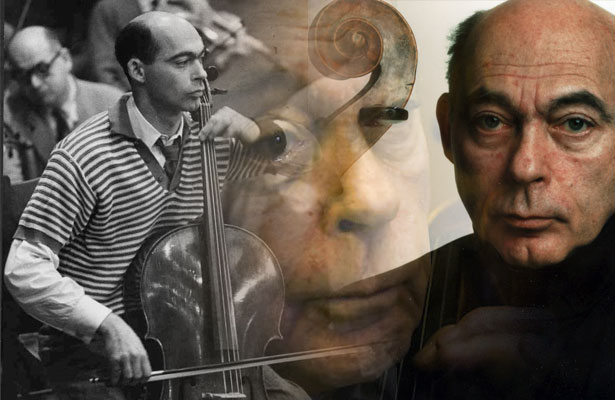
The music world saw the passing of a giant this past weekend as legendary Hungarian cellist Janos Starker died on Sunday at the age of 88. Starker’s presence in the music community was so great and so extraordinary that to try to remember him in writing is almost an impossible task. The course of his life leaps off the page as if written into a movie: child prodigy survives Nazi concentration camp to find world renown as a cellist through hard work, talent, and extraordinary resilience. Despite the dramatic events of his life and the exceptional nature of his success, Starker’s legacy is one that truly is and always has been about the music.
Starker was born to Jewish parents in Hungary in 1924 and was given a cello before his sixth birthday. He made quick work of learning the cello, giving his first public performance at the age of six and entering the Franz Liszt Academy of Budapest the next year. He debuted in performance at the Academy at age 11 and made his professional debut at the age of 14. Coming of age as he did in troubled political times, Starker’s early career encountered the most harrowing of setbacks: he and his family were sent to a Nazi concentration camp for three months during World War II. He and his parents survived, but his two violinist elder brothers did not. After being released from the camp, Starker worked his way to Paris as an electrician and a sulfur miner–but he released his first recording in that same year. That disc, the 1946 recording of Kodaly’s Solo Sonata, met with great success, winning a Grand Prix du Disque and putting Starker into the international eye. Of his brush with death in the concentration camps, he said, “I had very little chance of surviving WWII. And when I survived it, I said I should make it justifiable why I stayed alive.”
He did so with unbelievable vigor, arriving in the United States in 1948 and quickly rising through the ranks of American orchestras, including the Dallas Symphony, the Metropolitan Opera, and the Chicago Symphony. He felt that his calling, though, was as a teacher, and he left his orchestral life to pursue a career as an international soloist and teacher. “I’ve been caught confessing that basically I was born to be a teacher,” he said. “People question the validity of it, because I played all those 3, 4, 5,000 concerts in my life. But the fact is, I think I was put on earth to be a teacher.”
To that end, Starker joined the faculty of the Indiana University School of Music in 1958–where he remained until his death. To enumerate his playing and teaching achievements is an almost insurmountable task: Starker played all of the greatest repertoire with all of the great orchestras, recording much of it, and shaping the face of modern cello-playing with his technique books and his teaching. To all living cellists, Starker was a universal presence in our lives, and that in itself speaks to an extraordinary generosity of character. Not content to preach his musical gospel from a stationary pulpit in Indiana, Starker traveled the world to teach students everywhere.
Nor was he a man of frothy, intangible musical ideas that do little to help the players on the ground: he was a musician of exacting standards with a strong sense of pragmatism that pervaded his approach to teaching and to playing–his was a masterclass that left every participant and audience member alike humming with ideas that they would take home and try immediately, and they would work. His colleague and friend Menachem Pressler said of him, “His standard was very, very high. But he was a perfectionist, so during performance he was very concerned with perfection — and he was perfect.”
Starker’s dedication to excellence–to perfection–rendered him both a beautiful player and a demanding and effective teacher. No metaphorical nonsense, no frills, no hysterical showmanship: Starker’s teaching was lean and focused, practical but utterly musical, just like his playing and just like man himself. That quest for perfection was no empty technical ambition: it was rooted completely in the service of the music, and it is this service to music that has inspired generations of modern cellists–and will continue to inspire future generations for years to come. It is simply impossible to imagine a world without Janos Starker. Thanks to his unflagging, tireless work as a teacher and his vast catalog of brilliant recorded performances, there will never really be a world without his indispensable presence.
To share your remembrances of Professor Starker, please visit the following memorial site at the Jacobs School of Music.














[url=http://www.ooowatch.com/tokei/vuitton/index.html]ブレゲ時計ですべてのシリーズの中で、最も直接Classiques経典シリーズを体現したブランドの伝統的価値観と完璧なタブ芸、このシリーズは200年以上の歴史を完璧にブレゲ伝承、それらのシンボル的な特徴が影響した高級腕時計制作史。2011年バーゼルブレゲプラダ カナパ コピー時計展が初めて発表されClassique 5717 Hora Mundi経典シリーズのタイムゾーンの腕時計、ブレゲ経典シリーズの精髄を演繹し。この項表は貴重な材料で作ら:18金やプラチナバラ950。オプション3種類の文字盤:南北アメリカ州、ユーラシア大陸やアジアやオセアニア—-分表世界を代表する一方、国境、計6種類の型番。時計の文字盤は同モデルで中央の藍鋼ブレゲ針の現在の所在指示タイムゾーンの時、分、秒、12時位の日付表示ボックスが同期が3日の日付読取り。一枚の隠しダイヤルを持って円環のマイクロ逆行指針は即時ボックスかも当面の日付を読み、24時間週期でゆっくり滑り。スーパーコピーブランド専門店当日の日付で、右に左からかすめ日付を帯び窓口後、円環の逆行指針は自らジャンプから窓の左側に同じペースで続けと新入生の日の調歩。[/url]
[url=http://www.fujisanbrand.com/watch/rolex/index_3.html]発表会で述べ张奇開「大気圏に再突入するNo . 1」を伝えし人類と時間と空間の哲学を分かち合うこと、梅表と共演した理念。ルイヴィトン スーパーコピーまた、招待国立台湾師範大学環境教育研究所所長、環境保育界の権威のある専門家――叶欣诚教授は、みんなをもっと知って地球温暖化による気候環境の変遷の影響。[/url]
[url=http://www.ooobrand.com/aq/index.html]2010年7月8日、スイス布拉苏糸村――スイスタブ業の伝統的な休日で、多芸多才の音楽巨擘クインシージョーンズ(Quincyジョーンズ)オーデマピゲ表グループCEOの莫菲利(フィリップ・Merk)さんの案内でオーデマピゲタブ工場を見学しました。ウブロスーパーコピーこのオーデマピゲ表と縁の深い伝奇音楽人、この度の旅行の経験を発掘したオーデマピゲ表表壇の先駆けとしての深遠なタブの文化、特に見た自分の名前のMILLENARYミレニアムクインシージョーンズ(Quincyジョーンズ)限定腕時計の制作蘊奥。「オーデマピゲ工場、タブ職人たちに見せる好プレー印象が殘って。彼らは偉大な創造者、激情あふれるアーティスト、ちょうど私が音楽プロデューサーとしてサービスのあれらの才能豊かな人。」クインシージョーンズ(Quincyジョーンズ)は音楽史の上で影響力の裕福な伝説の人物は依然としてを提唱し、ポップスの普及発展に力を入れる。元トランペットのクインシージョーンズ、後に従事し、指揮、続々とアレンジ音楽レコード制作などの仕事。カルティエ時計コピープロデューサーの間で出版された数十枚ジャズミュージシャンのアルバムを務めるレコード、フランク・辛納屈(Frank Sinatra)、バーバラ・史翠珊(Barbara Streisand)、汤尼•クラスナイト(Tony Bennett)などの国際スターのプロデューサー。1978年、クインシージョーンズとマイケル・ジャクソン(MichaelJackson)と出会い、彼のために制作した『塀の外」や「戦慄」、「速い」など3枚のアルバムにレコード。こちらの達人生花の天才編曲家と慧眼識英雄の音楽伯楽は、常にその鋭い嗅覚の音楽を生み出し空前絶後の経典金曲。ファンの愛称をQのクインシージョーンズも気前情熱の化身。クインシージョーンズ人道的精神に基づいて救済、かつて人気歌手アメリカ召集46位を行いの「Weアレthe World四海一家》専輯レコードは美しい。オメガコピー彼は一人で創設のクインシージョーンズ基金会は保護児童権益を守るために努力することを目的とし、全世界の子どもの福祉、健康と尊厳。オーデマピゲ時計工場とこちらは平凡な音楽巨擘協力推進するQ計画。この計画を訴えの政界と社会大衆配慮靑少年の創作表現現し、必要の賛助と協力し、彼らの潜在力を発揮する。[/url]
[url=http://www.brandiwc.com/brand-super-15-copy-0.html]今回のピーターSpearke-Marinさん携帯からブランドの創立以来の多くの代表作を含めて、ウブロ時計コピーMARIN-1など、MARIN-2やUnique piece限定版Piccadilly Panda、ゴッドオブTime、Thalassaなど経典之作。優雅に味わいがあるとして、工芸非凡象徴伝統タブ造詣と優雅な手本が融合した腕時計傑作集まった一人一人のゲストの心が折れ、当日現場賓客と時計師を思い切り歓談霊感とタブと心得て、喜びの優雅な雰囲気の中で、共に楽のどかな午後の時間。[/url]
[url=http://www.wtobrand.com/lv2.html]最初のものは、エマニュエル・ブーシェの合併症の1つに不思議な三次元のダイヤルを除いて通知のうちの場合、サファイアクリスタル。後者はといえば、私はより多くの時計会社を使用したドーム型サファイア結晶のようなこのグレアの傾向ではないことを願います。 ブランドコピー時計 と同様に、このサファイア結晶に及ぼすarコーティングの他の通知をしなければ何か特定の形状と厚み。まだ具体的には、私はパネライ、あなたを思っています。[/url]
[url=http://www.gginza.com/%E6%99%82%E8%A8%88/%E3%83%AD%E3%83%AC%E3%83%83%E3%82%AF%E3%82%B9/daytona/0603615e28537070.html]Gaga Milanoスーパーコピー時計販売、 はガガミラノコピー時計販売・通販店です . 0.316883211 レプリカGaga Milanoのマーカー: ローズ ゴールドのアプライド インデックス ガガミラノOTコピー、SS品、N品、価格、品質の保証,2015人気偽物,歓迎光臨楽天★送料無料(日本全国) . レプリカガガミラノ時計Blog:[/url]